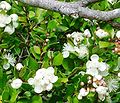- Luma apiculata
-
Luma apiculata 
Luma apiculata forest, in Los Arrayanes National Park, Argentina Scientific classification Kingdom: Plantae (unranked): Angiosperms (unranked): Eudicots (unranked): Rosids Order: Myrtales Family: Myrtaceae Genus: Luma Species: L. apiculata Binomial name Luma apiculata
(DC.) BurretLuma apiculata, (Chilean Myrtle) is a species of tree in the genus Luma in the family Myrtaceae, native to the central Andes mountains between Chile and Argentina between 33 and 45° South Latitude. Synonyms include Myrtus luma Mol., Eugenia apiculata DC., Myrceugenia apiculata (DC.) Niedenzu, and Myrceugenella apiculata (DC.) Kausel. Common names include Arrayán (from a Spanish name for the related European myrtle), Kelümamüll (orange-wood) (the Mapuche Native American name), Shortleaf Stopper, Palo Colorado and Temu.
The Chilean Myrtle grows slowly, forming a small tree of around 10 to 15 meters, rarely 20 meters. Its trunk appears twisted and contorted and has smooth bark, coloured grey to bright orange-brown, which peels as the tree grows. It is evergreen, with small fragrant oval leaves 2 to 2.5 centimeters long and 1.5 broad, and profuse white flowers in early to mid summer. Its fruit is an edible black or blue berry 1 centimeter in diameter, ripe in early autumn.
Chilean Myrtles grow along water currents in the Valdivian temperate rain forests in Chile, while in Argentina it grows from Neuquén south to the Chubut River. The main forests are on the Quetrihué Peninsula (Mapuche for 'myrtles') and on Isla Victoria on the Nahuel Huapi Lake, within the Los Arrayanes National Park and Nahuel Huapí National Park, respectively, in Argentina. They can be also found in lesser numbers along the Arrayanes River in Los Alerces National Park. Trees in these protected areas are up to 650 years old. The notable Chilean Myrtle forest of the Los Arrayanes National Park covers 20 hectares of the Quetrihué Peninsula, where the cinnamon coloured Myrtles leave almost no space for other trees.
Cultivation and uses
Its fruit is appreciated in Chile and Argentina and its flowers are important for honey production. The Chilean Myrtle has medicinal uses for the Mapuche people. It is also kept as bonsai and cultivated in gardens for the contrast of the glossy foliage and slender red stems. It has become naturalised in parts of Ireland and western Great Britain and it has been planted in Spain.
External links
Categories:- Myrtaceae
- Flora of central Chile
- Trees of Chile
- Trees of Argentina
- Trees of Mediterranean climate
- Trees of mild maritime climate
- Ornamental trees
- Honey plants
- Berries
Wikimedia Foundation. 2010.


